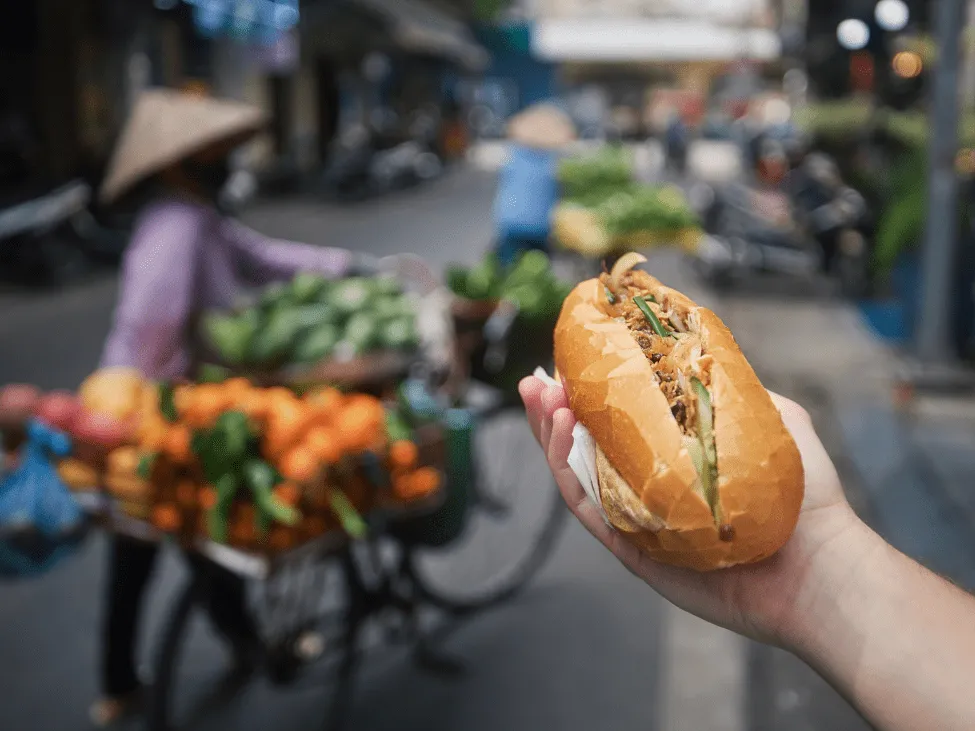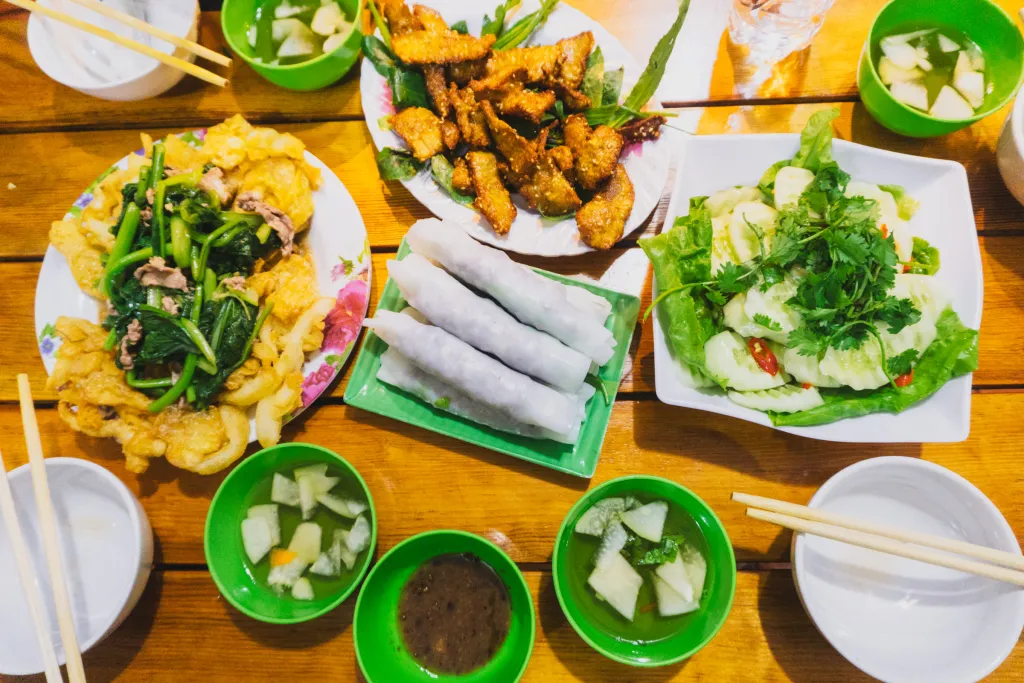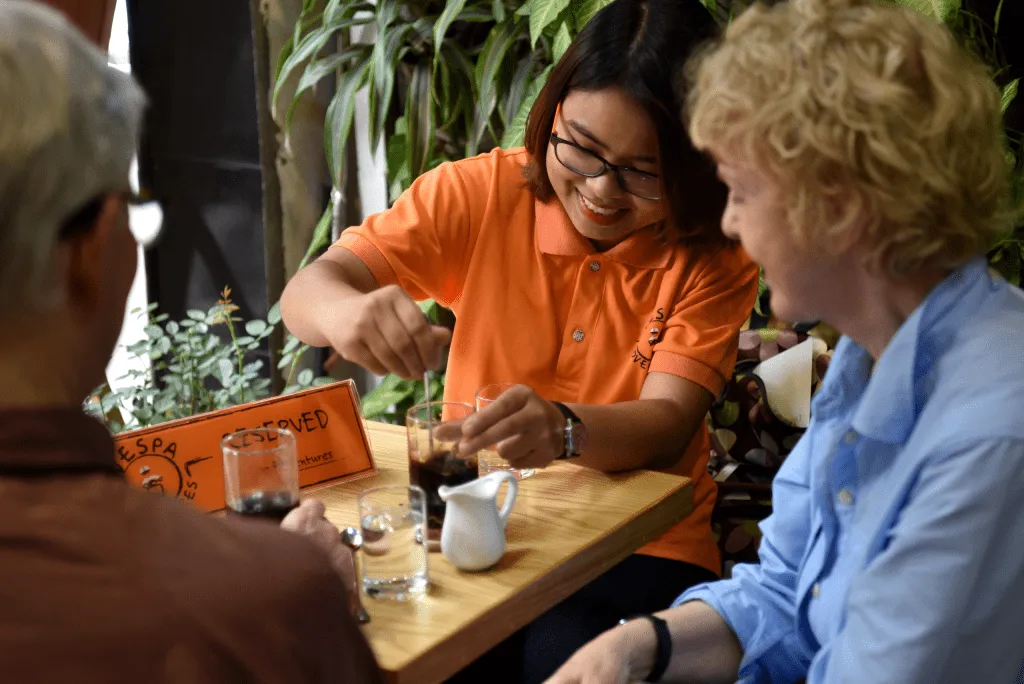Embarking on a Hanoi Food Tour is not just about eating; it’s a deep dive into the soul of Vietnam’s capital. Imagine the vibrant chaos of the Old Quarter, the symphony of motorbikes, and the intoxicating aromas wafting from street stalls at every turn. This sensory overload is the perfect backdrop for a culinary adventure. A well-chosen Hanoi Food Tour acts as your knowledgeable guide through this delicious labyrinth, ensuring you taste the best of the city while uncovering its rich history and culture, making it an experience far richer than just exploring on your own.
Hanoi’s street food scene is legendary, a complex tapestry woven with centuries of tradition. Navigating this vast culinary landscape can be overwhelming for newcomers. This is where a dedicated Hanoi Food Tour shines, offering curated experiences that highlight iconic dishes and hidden gems alike. It provides a structured yet authentic way to sample a variety of flavors, understand the ingredients, and learn the stories behind the dishes directly from local experts. It’s the easiest way to unlock the true taste of Hanoi.
Why a Hanoi Food Tour is Essential for Food Lovers
Joining a Hanoi Food Tour offers unparalleled benefits. Firstly, you gain access to truly local spots that you might never find independently. Guides often have long-standing relationships with vendors, ensuring you get the freshest and most authentic versions of popular dishes. This isn’t just about finding any Bún Chả stall; it’s about finding the best one known to locals.
Secondly, a food tour demystifies the process. What are the ingredients? How is it made? What’s the proper way to eat it? Guides provide context and cultural insights that turn a simple meal into a meaningful experience. They can also help navigate potential language barriers and dietary concerns, making your adventure smooth and worry-free. It transforms eating into a comprehensive cultural lesson.
Finally, a food tour is an immersive cultural experience. You see daily life unfolding around you, interact with vendors, and often use unique modes of transport like cyclos or Vespas, adding an element of excitement and authenticity that goes beyond simply sitting in a restaurant. It’s a dynamic way to feel the pulse of the city.
Kicking Off Your Hanoi Food Tour Adventure
Many Hanoi Food Tour experiences begin in or around the historic Old Quarter, the bustling heart of the city. The narrow streets, ancient houses, and constant buzz create an electric atmosphere. As you navigate this maze, the scent of grilled meats, simmering broths, and fresh herbs fills the air, immediately stimulating your appetite. This initial sensory immersion sets the stage for the culinary delights to come.
What to Eat in Fort Worth – A Culinary Deep Dive
Discover the Top Restaurants in Denver – A Culinary Journey
Discover Where to Visit in Las Vegas
Transportation often adds to the adventure. While walking tours are popular, exploring Hanoi on the back of a vintage Vespa offers a thrilling perspective. Zipping through the traffic, feeling the breeze, and having unobstructed views of the street life adds an adrenaline rush that perfectly complements the excitement of discovering new foods. It turns the journey between food stops into an experience in itself.
First Stops: Iconic Bites on Your Hanoi Food Tour
Your first tasting stops on a Hanoi Food Tour are likely to feature some undisputed champions of Vietnamese cuisine. These are the dishes that have earned Hanoi its reputation as a food paradise, and experiencing them fresh from a street vendor is a revelation. The simplicity of ingredients often belies the depth of flavor achieved through generations of culinary expertise.
Bánh Gối: Often translated as “Pillow Cake” or deep-fried dumpling, Bánh Gối is a delightful crispy treat frequently found near landmarks like St. Joseph’s Cathedral. The exterior is a golden, crunchy shell, giving way to a savory filling typically made from minced pork, mushrooms, vermicelli noodles, and sometimes quail eggs. It’s served with a sweet and tangy dipping sauce, often enhanced with pickled vegetables, creating a perfect balance of textures and flavors.
Trying Bánh Gối right where locals enjoy it – perhaps perched on a tiny plastic stool – connects you directly to the city’s street food culture. The sound of the crunch as you bite into it, followed by the burst of savory filling, is instantly rewarding. It’s a simple snack, but one that embodies the joy of spontaneous street eating in Hanoi, and it’s a must-try on any comprehensive Hanoi Food Tour.
 Vintage Vespa tour group enjoying street food at St. Joseph’s Cathedral in Hanoi.
Vintage Vespa tour group enjoying street food at St. Joseph’s Cathedral in Hanoi.
Bún Chả: Arguably one of Hanoi’s most famous dishes, Bún Chả is a harmonious combination of grilled pork, vermicelli noodles, and a flavorful dipping broth. The star is the pork, typically featuring both seasoned patties (chả) and thinly sliced pork belly (thịt nướng), grilled over charcoal until smoky and slightly caramelized. The aroma alone is enough to draw you in.
The magic happens when you combine the elements. You take a small bowl of the warm, slightly sweet and savory broth (nước chấm), which contains slices of green papaya or carrot, then add vermicelli noodles, fresh herbs (mint, basil, perilla leaves), lettuce, and the grilled pork. Eat it by dipping small bundles of noodles, herbs, and pork into the broth. The interplay of smoky meat, fresh greens, soft noodles, and tangy sauce is utterly addictive. Bún Chả is more than just food; it’s a communal eating ritual and a cornerstone of any authentic Hanoi Food Tour.
 A local guide serving Bún Chả to tourists during a Vespa tour in Hanoi.
A local guide serving Bún Chả to tourists during a Vespa tour in Hanoi.
Exploring Hidden Gems on Your Hanoi Food Tour
Beyond the absolute classics, a good Hanoi Food Tour will lead you down less-trodden paths to discover local favorites and variations that reveal the depth of the city’s culinary creativity. These spots might be tucked away in narrow alleyways or found in neighborhoods slightly outside the main tourist hub, offering a more authentic glimpse into Hanoian daily life and eating habits. Finding these places is part of the thrill.
These hidden gems often specialize in just one or two dishes, perfecting their craft over years, sometimes generations. The focus is on quality ingredients and traditional techniques passed down through families. Eating at such a place feels like being invited into a local secret, a privilege that enhances the flavor of the food itself. It’s about experiencing food where locals really eat.
The Beloved Bánh Mì
While popular throughout Vietnam, the Bánh Mì sandwich in Hanoi has its own distinct character. Reflecting French colonial influence, the Bánh Mì uses a light, airy baguette with a perfectly crispy crust. What goes inside, however, is pure Vietnamese ingenuity. Fillings can range from various cold cuts (chả lụa – Vietnamese ham, pate) to grilled meats (pork, chicken), sardines, or even fried eggs.
Equally important are the fresh accompaniments: pickled carrots and daikon, cucumber slices, cilantro, and often a smear of liver pate and mayonnaise or butter. A touch of chili sauce or fresh chilies adds a kick. The beauty of Bánh Mì lies in the incredible contrast of textures – the crunchy bread, the tender fillings, the crisp vegetables – and the complex layers of savory, tangy, and fresh flavors. Finding a truly exceptional Bánh Mì stand is a quest in itself, and a good Hanoi Food Tour knows just where to look.
 Travelers enjoying a traditional Bánh Mì sandwich in Hanoi on a Vespa food tour.
Travelers enjoying a traditional Bánh Mì sandwich in Hanoi on a Vespa food tour.
Lakeside Delights at West Lake
Escaping the intensity of the Old Quarter for a moment, some Hanoi Food Tour itineraries include a stop by West Lake (Hồ Tây). This large, serene lake provides a picturesque backdrop and a change of pace. It’s a popular spot for locals to relax, exercise, and enjoy food from lakeside vendors. The atmosphere here is noticeably calmer, offering a moment of tranquility amidst the culinary exploration.
Here, you might sample snacks specifically associated with the area or simply enjoy a refreshing drink while taking in the view. The shift in environment highlights the diverse settings in which Hanoians enjoy their food, from bustling streets to peaceful watersides. It demonstrates that food isn’t just about sustenance; it’s woven into the fabric of social life and leisure.
One snack often enjoyed near West Lake is Bò Bía. Unlike the deep-fried Bánh Gối, Bò Bía is a fresh spring roll. It typically contains jicama, carrots, dried shrimp, Chinese sausage, and herbs, all wrapped in a thin, translucent rice paper wrapper. It’s usually served with a rich, peanut-based dipping sauce. Bò Bía is light, refreshing, and offers a different textural experience compared to other Hanoi snacks, making it a great palate cleanser. Enjoying Bò Bía by the lake is a lovely way to experience a quieter side of Hanoi food culture.
 Serene West Lake, where tourists enjoy a snack of Bò Bía on the Hanoi Foodie Experience.
Serene West Lake, where tourists enjoy a snack of Bò Bía on the Hanoi Foodie Experience.
Unique Flavors & Experiences
A comprehensive Hanoi Food Tour seeks to showcase the diversity of Vietnamese cuisine beyond the most globally recognized dishes. It introduces variations on classics and unique local specialties that surprise and delight the palate. These moments often highlight the ingenuity and adaptability of Vietnamese cooking, where traditional flavors are presented in new and exciting ways, reflecting the evolving culinary landscape while honoring its roots.
Exploring these unique flavors adds layers to your understanding of Hanoi’s food identity. It shows that while certain staples are paramount, there’s also room for innovation and regional twists. A good guide can explain the origins of these dishes and their place in the local diet, enriching your tasting experience with valuable context and storytelling.
A Twist on a Classic: Phở Cuốn
Everyone knows Phở, Vietnam’s iconic noodle soup. But in Hanoi, you might encounter Phở Cuốn, a fascinating variation. Phở Cuốn translates roughly to “rolled pho.” Instead of thin rice noodles served in hot broth, Phở Cuốn uses wide, fresh rice noodle sheets (similar to those used for steamed rice rolls, Bánh Cuốn) as wrappers.
These wrappers are filled with stir-fried beef and a generous amount of fresh herbs like cilantro, basil, and mint. The rolls are served at room temperature with a dipping sauce that resembles the one used for Bún Chả, but perhaps slightly lighter. It captures the essence of Phở’s flavors and aromas – the fragrant herbs, the savory beef – but in a fresh, hand-held format. It’s a perfect example of how Vietnamese cuisine creatively reinvents itself and a delightful discovery on any Hanoi Food Tour.
 Phở Cuốn being served on a Vespa food tour through the streets of Hanoi.
Phở Cuốn being served on a Vespa food tour through the streets of Hanoi.
Beyond the Food: Atmospheric Stops
A truly memorable Hanoi Food Tour integrates more than just eating spots; it includes stops that offer unique cultural or atmospheric experiences that complement the culinary journey. These pauses allow you to digest (literally and figuratively), observe local life, and appreciate the city from different vantage points. They add layers of context and create lasting memories that go beyond just the taste buds.
One such unique spot could be a cafe located near the famous “Train Street,” where a train rattles mere inches from the buildings several times a day. Stopping at a place like Hỏa Xa Cafe offers a chance to sit, enjoy a drink (Vietnamese coffee, fresh juice, or local beer), and witness this incredible spectacle of urban life meeting active railway tracks.
This stop provides a moment to reflect on the vibrant, sometimes chaotic, yet always captivating energy of Hanoi. It underscores that the Hanoi Food Tour is about the entire experience – the sounds, the sights, the people, the atmosphere – not just the food itself. It’s a perfect way to end a tour, allowing you to soak in the city’s unique charm before heading back into the bustling streets.
 Hỏa Xa Cafe near the train tracks in Hanoi, where tourists relax after a Vespa tour.
Hỏa Xa Cafe near the train tracks in Hanoi, where tourists relax after a Vespa tour.
What Makes a Hanoi Food Tour Unforgettable?
The magic of a Hanoi Food Tour lies in its ability to weave together multiple facets of the city. It’s the combination of incredible food, insightful historical and cultural commentary from knowledgeable guides, the thrill of navigating the city’s streets, and the authentic interactions with local people. It’s a sensory symphony that educates, excites, and satisfies in equal measure.
A well-designed tour offers a narrative thread, moving from dish to dish, area to area, building a comprehensive picture of Hanoi’s identity through its cuisine. You don’t just eat; you learn why certain dishes are important, how they evolved, and what they mean to the people who eat and prepare them daily. This contextual understanding elevates the experience significantly.
Planning Your Hanoi Food Tour
Choosing the right Hanoi Food Tour depends on your preferences. Options range from walking tours focused solely on the Old Quarter to Vespa tours that cover more ground and add an element of adventure, or even specialized tours focusing on specific dishes or areas. Consider your interests – are you most keen on history, local life, or purely the food? Read reviews and check itineraries to find one that aligns with what you want to experience.
Come hungry! Food tours involve multiple generous tastings, so arrive with an empty stomach ready to explore. Wear comfortable shoes if it’s a walking tour. Be open-minded and adventurous – try everything offered, even if it looks or sounds unfamiliar. This is your chance to step outside your comfort zone and discover new favorites.
Consider the time of day. Day tours offer insights into bustling markets and lunchtime rituals, while evening tours provide a different ambiance, experiencing the city as it lights up and street vendors prepare for the dinner rush. Both offer unique perspectives on the Hanoi Food Tour landscape.
Frequently Asked Questions (FAQ) About Hanoi Food Tours
- How long does a typical Hanoi Food Tour last?
Most food tours in Hanoi last between 3 to 4 hours, providing ample time to visit multiple stops and sample various dishes. - How much does a Hanoi Food Tour cost?
Prices vary depending on the tour type (walking, Vespa, private), duration, and inclusions, but typically range from $40 to $80 USD per person. - Can Hanoi Food Tours accommodate dietary restrictions or allergies?
Many tours can accommodate some dietary needs (like vegetarian), but it’s crucial to inform the tour operator in advance. Be very clear about allergies, especially severe ones, as street food environments can have cross-contamination risks. - What’s the best time of year to take a Hanoi Food Tour?
Hanoi’s weather is most pleasant during the autumn (September to November) and spring (March to April). However, food tours operate year-round. Just be prepared for heat and humidity in summer, or cooler, damp weather in winter. - Should I book my Hanoi Food Tour in advance?
It’s highly recommended to book in advance, especially during peak travel season, as popular tours can sell out.
Conclusion
A Hanoi Food Tour is an absolute must for anyone visiting Vietnam’s capital. It’s a multi-sensory journey that goes far beyond simply tasting delicious food; it’s an immersive cultural experience that connects you with the heart and soul of the city. From the iconic Bún Chả and Bánh Mì to the unique Phở Cuốn and lakeside Bò Bía, each dish tells a story of history, tradition, and daily life. By joining a tour, you gain local insights, discover hidden culinary treasures, and create unforgettable memories navigating the captivating streets of Hanoi. Don’t just visit Hanoi; truly taste it on an incredible food tour.
